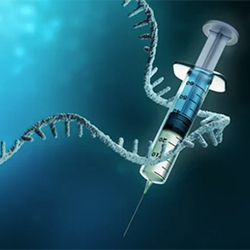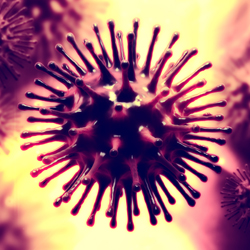By Marie Rosenthal, MS
This week’s roundup: The RECOVER study found that people on the front lines who were vaccinated with mRNA vaccines are 91% less likely to develop COVID-19, and if they do have a breakthrough infection, will suffer fewer symptoms for a shorter time than unvaccinated people. Something to think about this fall: Getting a flu shot might help to reduce severe COVID-19 symptoms, too. Antibiotic prescriptions fell by 25% among children during the pandemic, which researchers called “a silver lining” because many antibiotics given to children are unnecessary. Researchers look at developing an oral drug against COVID-19, and just how dirty is that money you handle every day?
mRNA Vaccines Slash COVID-19 Infection Risk by 91%
People who receive messenger RNA (mRNA) COVID-19 vaccines are up to 91% less likely to develop the disease than those who are unvaccinated. For those few vaccinated people who develop a breakthrough infection, the vaccines reduce the severity of COVID-19 symptoms and shorten its duration (N Engl J Med 2021;385[4]:320-329).

Researchers say these results are among the first to show that mRNA vaccination benefits even those individuals who experience breakthrough infections.
The RECOVER (Research on the Epidemiology of SARS-CoV-2 in Essential Response Personnel) study was designed to measure the risks and rates of infection among those on the front lines of the pandemic: physicians, nurses and first responders.
“These are the people who are getting exposure to the virus day in and day out, and the vaccine protected them against getting the disease. Those who unfortunately got COVID-19 despite being vaccinated were still better off than those who didn’t,” said Sarang Yoon, DO, a study co-author; an assistant professor at the University of Utah Rocky Mountain Center for Occupational and Environmental Health, in Salt Lake City; and the principal investigator of the RECOVER study.
The study found that mRNA COVID-19 vaccines were:
- 91% effective in reducing risk for infection once participants were fully vaccinated, two weeks after the second dose; and
- 81% effective in reducing risk for infection after partial vaccination, two weeks after the first dose but before the second dose was given.
The researchers recruited 3,975 participants at eight sites: Salt Lake City; Miami; Temple, Texas; Portland, Ore.; Duluth, Minn.; and Phoenix and Tucson, as well as other areas in Arizona. Participants submitted weekly samples for COVID-19 testing for 17 weeks between Dec. 13, 2020, and April 10, 2021. In addition, participants gave weekly updates about any COVID-19–like symptoms including fever, shortness of breath, and loss of taste and smell.
Only 204 (5%) of the participants tested positive for SARS-CoV-2. Of these, 156 were unvaccinated, 32 had an indeterminate vaccine status, and 16 were fully or partially vaccinated. The fully or partially vaccinated participants who developed breakthrough infections had milder symptoms than those who were unvaccinated:
- Fever was reduced 58%.
- Days spent sick in bed were reduced by 60%.
- Detection of the virus was reduced by 70% from 8.9 to 2.7 days.
The three people who were hospitalized were not immunized, meaning that no one who developed a breakthrough infection was hospitalized.
Do Flu Shots Protect Against Severe Effects of COVID-19?
Influenza vaccine may provide vital protection against COVID-19 (PLoS One 2021;16[8]:e0255541 https://doi.org/10.1371/journal.pone.0255541).

Physician-scientists from the University of Miami Miller School of Medicine analyzed de-identified patient records from around the world, which strongly suggested that the annual influenza vaccine reduces the risk for stroke, sepsis and deep vein thrombosis (DVT) in patients with COVID-19. Patients with COVID-19 who had been vaccinated against the flu were also significantly less likely to visit the emergency department (ED) and be admitted to the ICU.
“Only a small fraction of the world has been fully vaccinated against COVID-19 to date, and with all the devastation that has occurred due to the pandemic, the global community still needs to find solutions to reduce morbidity and mortality,” said senior study author Devinder Singh, MD, the chief of plastic surgery and a professor of clinical surgery at the Miller School of Medicine.
The team screened de-identified electronic health records on the TriNetX research database for more than 70 million patients from a number of countries, including the United States, the United Kingdom, Germany, Italy, Israel and Singapore, to identify two groups of 37,377 patients. The two patient groups were matched for factors that could influence their risk for susceptibility to severe COVID-19, including but not limited to age, sex, ethnicity, smoking, and health problems such as diabetes, obesity and chronic obstructive pulmonary disease.
Members of the first study group had received the flu vaccine no later than six months prior to being diagnosed with COVID-19. Those in the second group also had a positive COVID-19 diagnosis but had not received a flu shot. The incidence of 15 adverse outcomes (sepsis, stroke, DVT, pulmonary embolism, acute respiratory failure, acute respiratory distress syndrome, arthralgia or joint pain, and renal failure; anorexia; heart attack; pneumonia; ED visits; hospital admission; ICU admission; and death) within 30, 60, 90 and 120 days of testing positive for COVID-19 was then compared between the two groups.
The analysis revealed that people who were not vaccinated against influenza were significantly more likely (up to 20% more likely) to have been admitted to the ICU. They were also significantly more likely to visit the ED (up to 58% more likely), to develop sepsis (up to 45% more likely), and to have a stroke (up to 58% more likely) and DVT (up to 40% more likely). The risk for death was not reduced.
The investigators were also able to calculate how many COVID-19–positive patients would need to receive an influenza vaccine to avoid one adverse outcome. Of note, they found that only 176 patients needed to have received a flu vaccine to prevent one ED visit within 120 days of testing positive for COVID-19. In addition, only 286 patients needed to have received their flu vaccine to prevent one case of sepsis, which is known to be the most expensive condition to treat in the U.S. health care system. Finally, for every 440 patients who were up-to-date on their flu shot, one ICU admission was prevented.
The results strongly suggest that the flu vaccine may help protect against several severe effects of COVID-19, the study authors said. However, they strongly recommend that people receive COVID-19 vaccines and their annual influenza vaccine.
Antibiotic Prescriptions for Kids Plummet During Pandemic
Researchers who found that antibiotic prescriptions for children plunged by nearly 56% between April and December 2020, compared with the same period in 2019, called it a small “silver lining” from COVID-19, because so many pediatric prescriptions for antibiotics are unnecessary.

Overall prescriptions for children dropped by more than 25% during the first eight months of the pandemic compared with the previous year, with the steepest declines in infection-related medicines like antibiotics and cough-and-cold drugs (Pediatrics 2021;148[2]:e2021049972).
As children made fewer visits to health facilities and engaged in social distancing and other COVID-19 mitigation measures, a smaller number of them also received prescription drugs.
“The decline in the number of children receiving antibiotics is consistent with the large decreases in infection-related pediatric visits during 2020,” said lead author Kao-Ping Chua, MD, PhD, a pediatrician and researcher at University of Michigan Health C.S. Mott Children’s Hospital and the Susan B. Meister Child Health Evaluation and Research Center, in Ann Arbor.
“Because antibiotics have important side effects, the dramatic decreases in antibiotic dispensing may be a welcome development,” he added. “However, declines in dispensing of chronic disease drugs could be concerning.”
Researchers analyzed national prescription drug dispensing data from 92% of U.S pharmacies to assess changes in dispensing to children 0 to 19 months of age during COVID-19.
Between January 2018 and February 2020, nearly 25.8 million prescriptions were dispensed to children per month. Dispensing totals during the first eight months of the pandemic dropped by about 27% compared with the same period in 2019.
Overall, drugs typically prescribed for acute infections, including antibiotics, fell by nearly 51% while those for chronic diseases fell by 17%.
“The decrease in antibiotic dispensing most likely reflects reductions in infections, such as colds and strep throat, due to COVID-19 risk mitigation measures like social distancing and face masks,” Dr. Chua said.
“As a result, children had fewer infection-related visits and had fewer opportunities to receive antibiotic prescriptions, whether for antibiotic-appropriate conditions or antibiotic-inappropriate conditions.”
Dr. Chua’s previous research suggested that nearly one-fourth of antibiotic prescriptions among children and adults may be unnecessary. In children, antibiotics are the leading cause of ER visits for adverse drug events, with potential side effects including allergic reactions, fungal infections and diarrhea.
Another welcomed development in drug dispensing trends, the researchers found, was a decline in prescription medicines to treat symptoms of the common cold, particularly to suppress coughs.
Findings suggest a nearly 80% drop in antitussive drugs during the 2020 study period.
“These drugs have little benefit but are associated with potentially harmful side effects, particularly in young children,” Dr. Chua said.
“From the perspective of health care quality, the sharp decline in dispensing of cough-and-cold medications may represent a silver lining of the COVID-19 pandemic,” he said.
The decreased dispensing in kids is consistent with the drop in total number of prescriptions dispensed to adult Americans, which declined sharply during the pandemic but subsequently rebounded. However, the study indicates dispensing to children has not rebounded to the same degree, Dr. Chua said.
Rethinking Remdesivir: What If It Was Oral?
Remdesivir (Veklury, Gilead) is an FDA-approved antiviral drug, which measurably reduces recovery time for hospitalized COVID-19 patients.
But it must be administered intravenously, a process that restricts its use to patients hospitalized with relatively severe or advanced cases of COVID-19.
Researchers at UC San Diego School of Medicine describe cell and animal studies that demonstrate how lipid modifications of remdesivir nucleoside can improve drug delivery, effectiveness and toxicity compared with the approved version of remdesivir (Antimicrob Agents Chemother 2021 Jul 26. doi:10.1128/AAC.01155-21).
“Although vaccine development has had a major impact on the epidemic, COVID-19 has continued to spread and cause disease—especially among the unvaccinated,” said co–first author Robert T. Schooley, MD, a professor of medicine at UC San Diego. “The need for effective, well-tolerated antiviral drugs that can be given to patents at high risk for severe disease at early stages of the illness remains high.”
Senior author Karl Hostetler, MD, a professor of medicine at UC San Diego, and his colleagues synthesized three new lipid prodrugs, which combine remdesivir nucleoside with one of several types of lipid phosphates. The resulting conjugated molecule uses new pathways to enter cells: the lipid phosphate portion carrying along the drug.
The lipid phosphate prodrugs of the remdesivir nucleoside can be taken orally, remaining intact and bioactive in the body following absorption from the digestive system.
“COVID-19 is a two-stage disease,” Dr. Schooley said. “Rapid viral growth occurs shortly after infection and can trigger a misdirected immune response that results in an ‘inflammatory’ pneumonia in those who don’t do well. In order to be maximally effective, antiviral therapy must be given early in the illness before the inflammatory phase of the illness results in hospitalization. These compounds are designed to be taken orally, rapidly absorbed from the gastrointestinal tract and to largely bypass the liver where most of remdesivir’s toxicity is seen.”
To become active, remdesivir requires modification by multiple enzymes. This complicated metabolism likely contributes to variable antiviral activity and toxicity in different cell types. For example, remdesivir works well in lung cells, but is less effective in other organs and relatively more toxic in hepatocytes, which limits the amount of drug that can be administered to patients. In comparison, the lipid prodrugs described here are activated by a single enzymatic reaction and show a consistently potent antiviral activity and minimal toxicity across many cell types.
The researchers assessed the lipid prodrugs in a variety of animal and human cell types and found that the lipid prodrugs uniformly inhibited SARS-CoV-2 RNA replication across cell types. They were well tolerated by hamsters, with levels of the drug remaining stable and persistent.
“We believe that lipid prodrugs of this type, after further development, may reduce the severity of COVID-19 infections and reduce hospitalizations,” Dr. Hostetler said.
Dirty Money?
A new study found that money might not be all that dirty—at least as far as COVID-19 is concerned.

Experts at the European Central Bank and the Ruhr-Universität Bochum wanted to find out how long coronaviruses remained on banknotes and coins, and whether a person could become infected by handling cash. So, researchers led by Eike Steinmann, PhD, and Daniel Todt, PhD, MS, of the Department of Medical and Molecular Virology at Ruhr-Universität Bochum, developed a method to test how many infectious virus particles can be transferred from cash to the skin in real-life conditions (iScience 2021 Jul 26;102908. doi:10.1016/j.isci.2021.102908).
The researchers treated various euro coins and banknotes with virus solutions of different concentrations and over several days observed how long infectious virus was still detectable. A stainless steel surface served as a control in each case.
The results are reassuring: While infectious virus was still present on the stainless steel surface after seven days, on the 10-euro banknote, it took only three days to completely disappear. For the 10-cent, 1-euro and 5-cent coins after six days, two days and one hour, respectively, no infectious virus was detectable.
“The rapid decline on the 5-cent piece is because it’s made of copper, on which viruses are known to be less stable,” Dr. Todt said.
The research team developed a new method to study how well the virus is transferred from a surface to the fingertip. They contaminated banknotes, coins and credit card–like plates with harmless coronaviruses and, under high-security conditions, also with SARS-CoV-2.
These surfaces were then touched, while still wet or when already dried, by test subjects with their fingertips or, in the case of SARS-CoV-2, artificial skin. Cell cultures were then inoculated with the viruses adhering to the fingertips. This allowed the researchers to determine the number of transmitted virus particles that were still infectious.
“We saw that immediately after the liquid had dried, there was practically no transmission of infectious virus,” Dr. Todt said. “Under realistic conditions, infection with SARS-CoV-2 from cash is very unlikely.”
The study was conducted with the original virus and the Alpha variant of SARS-CoV-2. They said they expect other variants to react similarly.
{RELATED-HORIZONTAL}
